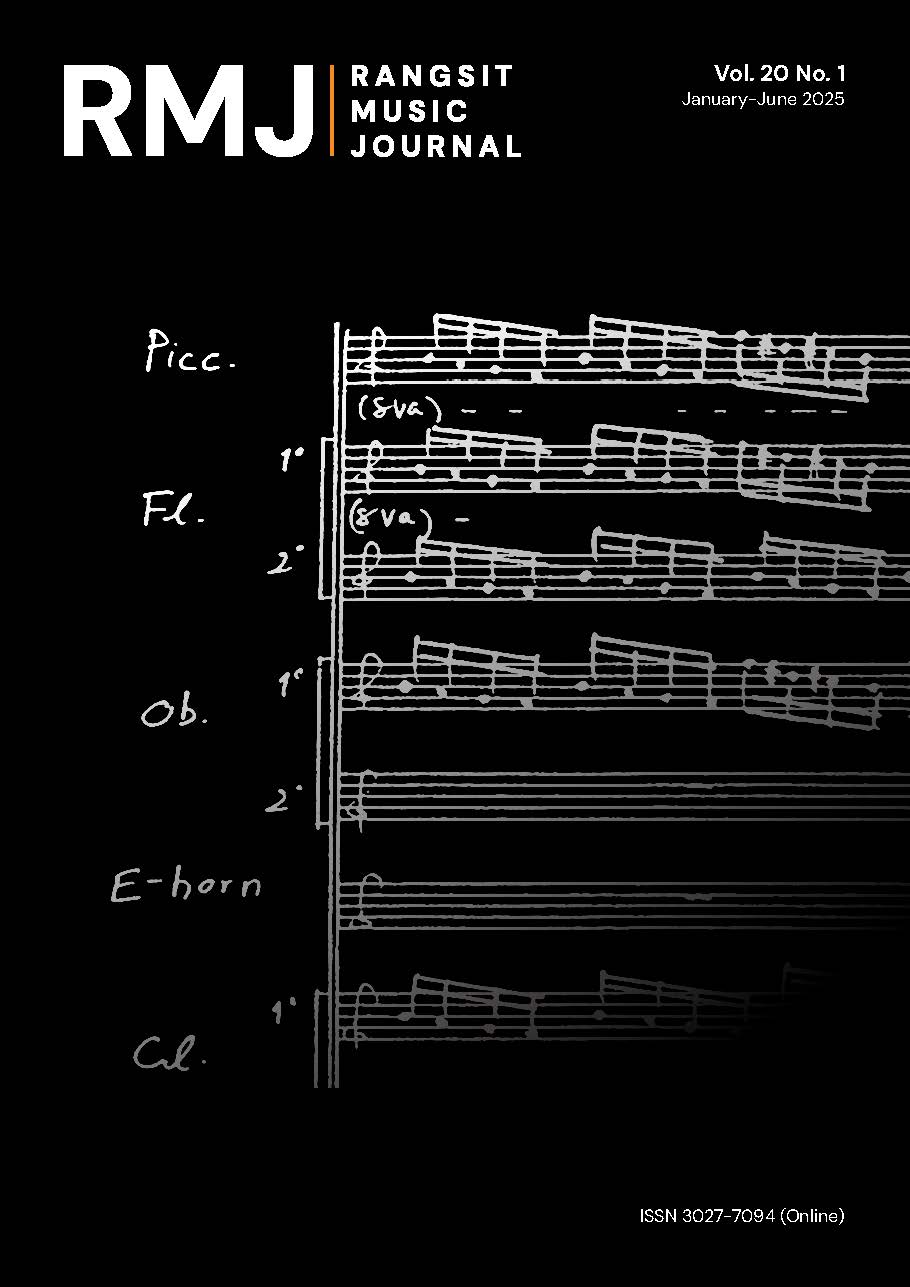A Practice Routine for Adding Harmonic Interest to Single Note Melodies for Improvisation
DOI:
https://doi.org/10.59796/rmj.V20N1.2025.A0202Keywords:
Improvisation, Jazz, LeapsAbstract
This article presents and examines a set of short exercises designed to improve improvisation skills and develop harmonic interest in single-line melodies. For aspiring improvisers, the preparation, practice and spontaneous performance required to effectively improvise on a jazz standard can appear daunting. The basic elements include mastering the appropriate scales, guide tones, arpeggios (with or without extensions such as 9ths, 11ths, 13ths), ear training and developing rhythmic proficiency. Jazz improvisation, despite its inherent spontaneity, often involves significant advance preparation. This contrasts with the literal meaning of the 16th century Italian word "improvisare" which means to perform on the spot without preparation. Playing over chord changes demands a solid understanding of harmony, along with the ability to apply this knowledge in real time.
In the initial stages of learning, students focus on mastering the correct scales. As they progress, they explore how to navigate chord progressions effectively, enabling them to create melodies that resonate harmonically with the underlying chord. Common techniques such as targeting chord notes, guide tones, tensions, and chromatic approaches, create emotional impact and harmonic expectation. Developing these competencies is a gradual process that requires significant time and harmonic knowledge and is often deferred to later stages in the learning journey, with initial focus on playing scale patterns. In essence, when a student is unable to outline the chord(s) they typically resort to playing scale patterns as an alternative. How can we integrate harmonic interest into our improvisational practice without requiring extensive knowledge of music theory? Is it possible to cultivate harmonic interest in improvisation at an early stage without playing over predefined chord progressions such as IV-V-I or II-V-I?
The objective of this approach is to design a practice routine with simple exercises that plant the seeds for harmonic interest in melodic ideas for improvisation through the use of leaps. The proposed exercises take a slightly different approach by emphasizing the use of jumps or leaps at an earlier learning stage. They are based on my own teaching experience and the teachings that were passed down to me over the years. These exercises are applicable to both beginners and more experienced improvisers and focus on a single key center. Over time, these drills become second nature, enabling us to apply them seamlessly in our improvisation. Furthermore, these routines will enhance our harmonic ear.
When we jump or leap from one note to another, thus creating an interval of a third or greater, our brain engages in a fascinating process. A virtual note or virtual resonance is created. It is a note that appears to be present although it is not explicitly played. Our brain retains the memory of the first note at the time the second note is played, creating the auditory impression of an interval, thereby generating harmonic interest. It can even imply a chord. In the exercises presented each note that jumps is resolved to the underlying chord triad through correct voice leading. A rhythm track and drone of the underlying triad is used to help us hear the resolutions and make the exercises more enjoyable to practice.
The first exercise introduces this principle by utilizing only diatonic notes with immediate resolution to the triad. It involves single leaps from a chord tone to a non-chord tone that is then resolved back using proper voice leading. This drill is meant to make voice leading a natural skill, so it becomes second nature. We memorize the resolution paths to the target notes, and this might take some time for an aspiring improviser, but it will become easier when scale fragments are added later. The second exercise consists of two consecutive leaps. Both leaps are resolved to the chord note but the resolution of the first note is delayed, resulting in immediate and delayed resolution of non-chord tones. Again, only diatonic notes are used here. This is more complex as we need to memorize the two notes that need to resolve. In the third exercise scale passages are added to exercises one and two. When playing scales in steps no resolution is needed, which will make it a bit easier to apply in improvisations. The fourth exercise adds rhythm displacement to the above. Lastly the fifth exercise uses all chromatic notes and applies them to the previous exercises.
The result is an improvisational device that uses leaps, scale fragments, or both that are resolved using voice leading principles of Western tonal music. Over time and with good practice these techniques will blend into your improvisational language, promoting your harmonic interest and developing your ear. After all, an improviser sounds how he practices at home. Once one gets used to using leaps and delayed resolution, adding non-diatonic notes will result in interesting melodic ideas All chromatic notes are used here, and none of the examples use complex scales such as altered scales or diminished scales. These 10-minute exercises provide a melodic framework for improvisation that remains harmonically suggestive and harmonically balanced. Because of their strong gravitational pull toward the underlying key, they can serve as possible alternative ideas for improvisation on a dominant-tonic or subdominant-dominant-tonic progression. Incorporating these skills at an early stage of musical development helps to cultivate the harmonic ear and prehearing skills which are key components of musical improvisation.
References
Crook, Hal. How to Improvise: An Approach to Practicing Improvisation. Rottenburg: Advance Music, 1990.
Levine, Mark. The Jazz Piano Book. Petaluma, CA: Sher Music Co., 1989.
Ligon, Bert. Comprehensive Technique for Jazz Musicians. Milwaukee, WI: Hal Leonard, 1990.
Ligon, Bert. Jazz Theory Resources Volume 1. Milwaukee, WI: Hal Leonard, 2001.
Schoenberg, Arnold. Structural Functions of Harmony Edited by Leonard Stein. New York: W.W. Norton, 1954.
Van Dormael, Pierre. Four Principles to Understand Music. Brussels: Art Public Publishing, 2008.
Downloads
Published
How to Cite
Issue
Section
License
Copyright (c) 2025 Rangsit Music Journal

This work is licensed under a Creative Commons Attribution-NonCommercial-NoDerivatives 4.0 International License.







